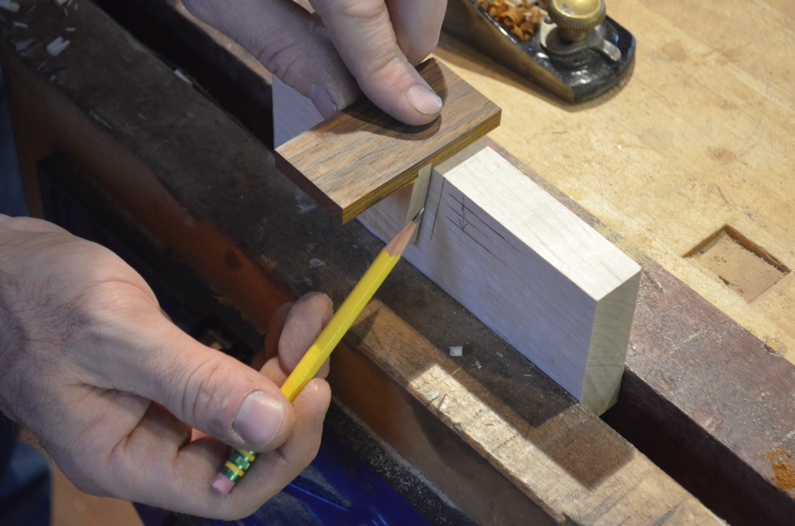Read all about Frank’s dresser project progress.

Tools used for making a dovetail marker
As I mentioned in my last blog, I had to make myself another dovetail marker because I left mine at the school shop.
Making a dovetail marker is not too hard, but I have chosen to make it a little harder by using a tapered sliding dovetail to join the two pieces together. You could simply use a dado joint and just glue it in.
I started with two contrasting woods, curly maple and cocobolo. These pieces are 5/16″ thick and 1 1/2″ wide. They are oversize in length, so we’ll cut them off to size later. A shooting board is a must when you are cutting dovetail markers: the ends have to perfectly square. Start by shooting the end of one of the pieces that you want the tail to be on.

Shooting the end of the tail board
I then set my cutting gauge to about half the thickness of the stock (5/32″) and scribe on one end of the piece you want to be the tail.

Scribing the end of the tail board
I lay out the angles of the tail and the tapers on the top, again I can’t say too much here for fear I might breach my contract with Popular Woodworking! I will be writing an article next week for the magazine that will be published early next year on how to cut a tapered sliding dovetail.
Here I am using my Lie-Nielsen dovetail saw for cutting the tapers. By the way, if you don’t have one of these saws and you’re serious about cutting dovetails, drop what you’re doing, go to Lie-Nielsen’s website and buy the saw now! It’s an amazing saw.

Cutting the tapered tail

The finished tail
Now that the tail is cut, I will transfer it to the pin board (the cocobolo piece), using a knife. Also mark the depth of the pin recess using the same cutting gauge setting that you used to mark the tail board. Then cut the side walls and chisel out the waste. I am using a 1/8″ chisel here.

Chiseling the waste on the pin board
Well, here is the moment of truth! If you cut it perfectly, no paring should be needed and it should go together in one easy swoop. Much easier said than done: usually I have to pare a little on the sides of the pin board to allow it to go together perfectly.

The moment of truth!

Almost home!

Finally fit!
Crisp clean cuts both in the shoulder of the tail as well as the bottom of the pin recess are extremely important. The smallest little bit can keep the whole thing from going together.
Now I cut the excess off the ends. I usually just cut it off by eye and it works out to where the tail-piece is 1 3/4″ long and the pin board is a total length of 3″ long.
The next step is to mark the angle. I set a bevel square to a pleasing angle (I like a 1:7 ratio), and mark both sides on the tail board (maple piece) and cut off the angles.

Marking the angle

Cutting the angles
Then just clean it up with a plane. You will want to check to see that the angles are accurate. You may need to plane one side or another to get it to be the same. You will also need to check to make sure that the top piece is square: put the dovetail marker up in place as if you were going to use it and slide a square right up against it. It is imperative that the top is dead square; if it’s not, simply set your block plane to a very fine setting and plane it square.

Checking the angles

Checking for square

Finished dovetail marker
To see the marker in use just view the last blog post on laying out dovetails for the dresser.
Well, if you are totally confused by the process on how to make one of these little tools, just come down to the Woodworking Show this weekend in Conroe, Texas, just north of Houston. I will be there and will be making a few of these dovetail markers as well as demonstrating regular easy dovetails and hand planes and maybe even a little inlay. The show is this weekend, October 24-26.
See you soon!
Frank Strazza
To see these dovetail markers in action, sign up for our online Basics of Joinery Course to watch our online video, Cutting the Dovetail Joint, and get other in-depth classes on dovetails and other joints. To preview the Joinery course, see our free video, A Dovetail Demonstration. For a full-blown dresser project, sign up for our on campus Four Drawer Dresser course.
Comments are closed.